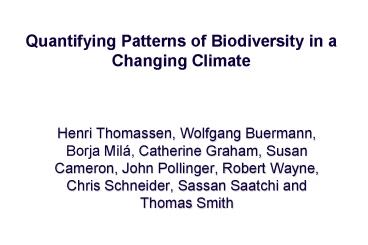Quantifying Patterns of Biodiversity in a Changing Climate - PowerPoint PPT Presentation
Title:
Quantifying Patterns of Biodiversity in a Changing Climate
Description:
Quantifying Patterns of Biodiversity in a Changing Climate – PowerPoint PPT presentation
Number of Views:65
Avg rating:3.0/5.0
Title: Quantifying Patterns of Biodiversity in a Changing Climate
1
Quantifying Patterns of Biodiversity in a
Changing Climate
- Henri Thomassen, Wolfgang Buermann, Borja Milá,
Catherine Graham, Susan Cameron, John Pollinger,
Robert Wayne, Chris Schneider, Sassan Saatchi and
Thomas Smith
2
(No Transcript)
3
Biodiversity Hotspots
4
Two limitations of hotspots
- 1) may fail to capture regions important in
generating or maintaining adaptive variation - 2) may fail to take into account climatic change
5
Moving beyond simple surrogates of
biodiversityPutting Process on the Map
- The steps
- 1) Assess biodiversity pattern
- 2) Assess biodiversity process
- 3) Predict the influence of climate change
- 4) Combine 1-3 and levels of threat to identify
critically important regions
6
Framework for mapping pattern and process
Localities of presence Habitat suitability
map Species distribution map
- Non-linear matrix regression technique
- Association between environmental variables
- and genetic/phenotypic differences
- 2. Predict pattern across landscape
7
Ecuador
1984
1997
8
Combined point locality, genetic and phynotypic
with bioclimatic and remote sensing data
- Birds
- Bats
- Frogs
- Small mammals
- Primates
- Trees
- distribution data only
9
Wedge-billed Woodcreeper (Glyphorhynchus spirurus)
15 sampling sites, N178 136 AFLP
loci Morphology wing, tarsus, tail lengths, bill
width, depth, length
10
Spatial Analysis Model
Remote Sensing Environmental Variable Layers
Land Cover
Phenology
Species Dsitribution (MAXENT)
Topography
Landscape Metrics
Current Predicted species Distributions
Rainfall/Temperature
Species Point Locality Data
11
Environmental Variables
Data Record Instrument Ecological attributes Variables derived
Leaf Area Index (LAI) Satellite-MODIS Vegetation density, seasonality and net primary productivity LAImax, LAIrange
Percent Tree Cover Satellite-MODIS Forest cover and heterogeneity Treecover
Scatterometer-Backscatter Satellite-QSCAT Surface moisture and roughness (forest structure),seasonality QscatMean, QscatStd
DEM SpaceShuttle SRTM Topography and ruggedness SRTM_MEAN, SRTM_STD
WorldClim Station Network Bioclimatic variables Various temperature and precipitation variables
measures of distance geographic distance,
Least-Cost-Paths, Resistance Distances
12
Results Maxent species distribution
10 threshold 2000 m cutoff
Mask for GDM
13
Spatial Analysis Model
Remote Sensing Environmental Variable Layers
Genetic Diversity
Phenotypic Diversity
Land Cover
Current Predicted patterns of Diversity
Phenology
Species Dsitribution (MAXENT)
Spatializing Pattern/process (GDM)
Topography
Landscape Metrics
Current Predicted species Distributions
Rainfall/Temperature
Species Point Locality Data
14
Tarsus length - East of the Andes
Variables included in model explained
Geographic distance environment 70.5
Geographic distance 10.9
Environmental variables 70.5
15
Foothills 800-1500m
Lowlands 0-500m
16
Morphological analysis
Tarsus length Bill length
16.8
11.4
16.6
11.2
16.4
11.0
TARSUS (mm)
UPPER MANDIBLE LENGTH
16.2
10.8
16.0
10.6
15.8
10.4
57
81
N
58
80
N
FOOTHILLS
LOWLANDS
LOWLANDS
FOOTHILLS
17
Lowlands
Foothills
18
Results GDM
AFLPs, entire Ecuador
Variables included explained
EnvironmentAndean barrier 95.2
Andes as barrier (isolation) 93.2
Environmental variables 90.5
19
AFLPs - East of the Andes
Variables included explained
Geographic distance environment 72.2
Geographic distance 8.8
Environmental variables 71.5
20
Masked Flower Piercer (Diglossa cyanea)
of total variance explained
Microsatellites (8 loci) 51.0
Bill length 70.8
Photo J.A. Chaves
21
Streak-necked Flycatcher (Mionectes
striaticollis)
Photo J.A. Chaves
of total variance explained
Microsatellites 41.9
Bill width 60.2
Bill depth 72.6
West view
West view
Bill depth
Bill width
East view
East view
22
Comparison to currently protected areas
Areas of particularly high turnover.
- Adaptive variation particularly found along
elevational gradients - High turnover for all investigated species and
traits along northwestern and northeastern slopes
of Andes, where few areas are currently protected.
Hatched areas are currently protected (source
IUCN).
23
Spatial Analysis Model
Degree of Threat Opportunity/ Stakeholder
Input
Remote Sensing Environmental Variable Layers
Genetic Diversity
Phenotypic Diversity
Land Cover
Current Predicted patterns of Diversity
Phenology
Species Dsitribution (MAXENT)
Spatializing Pattern/process (GDM)
Topography
Landscape Metrics
Current Predicted species Distributions
Rainfall/Temperature
Species Point Locality Data
24
Threats and opportunities and stakeholder input
25
Spatial Analysis Model
Degree of Threat Opportunity/ Stakeholder
Input
Remote Sensing Environmental Variable Layers
Genetic Diversity
Phenotypic Diversity
Land Cover
Current Predicted patterns of Diversity
Phenology
Species Dsitribution (MAXENT)
Spatializing Pattern/process (GDM)
Topography
Landscape Metrics
Current Predicted species Distributions
Rainfall/Temperature
Species Point Locality Data
26
Predicted Range for Speckled Hummingbird
(Adelomyia melanogenys)
Point Locations
0 2 5 10 20 gt50
Worst conditions
Optimal conditions
27
(No Transcript)
28
Net loss of speckled hummingbird habitat with
climate warming (double CO2
experiment)
Scenario 1 With only temperature change
East Slope Andes
Areas becoming less suitable
Areas becoming more suitable
West Slope Andes
Habitat loss12,000 km2
29
Conclusions
- Gradients can be important drivers of adaptive
genetic variation - Conserving gradients may offer a bet hedging
approach for conserving adaptive variation in the
face of climate change - Integrating biodiversity pattern, process and
degree of threat may offer a valuable approach
for prioritizing regions for conservation
30
Thanks to
Woody Turner































